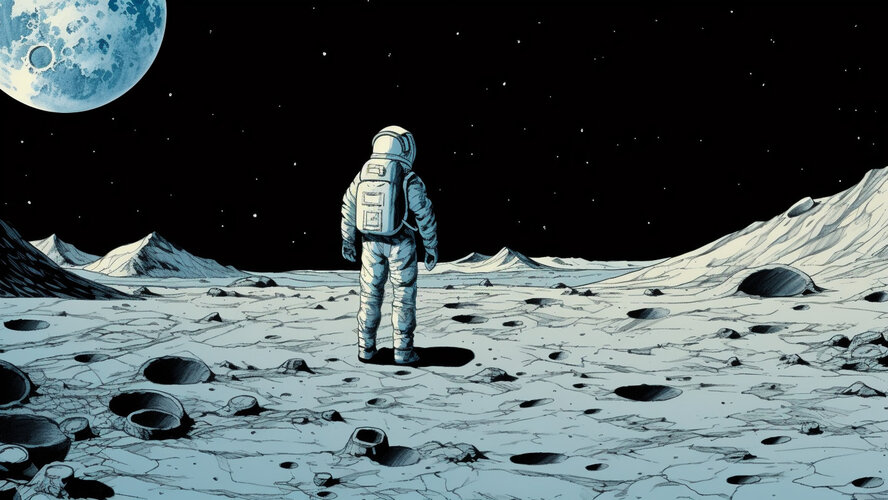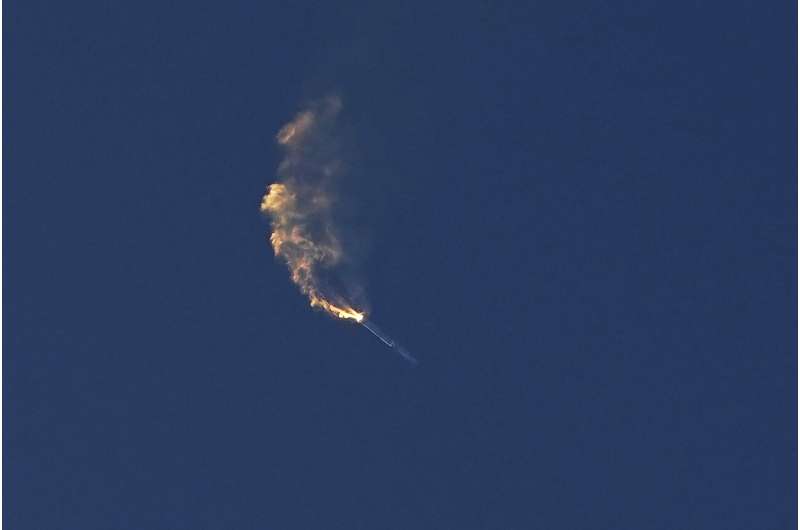Just a Little Scoot: Sols 3814-3816
Tuesday, 02 May 2023 11:08 We arrived this morning to Curiosity at a new location with some bright toned, and more rounded rocks in our vicinity. Unfortunately, we could look but not touch as our wheels were positioned such that we could not safely unstow the arm for contact science. We typically have a large suite of arm activities in weekend plans but with those now removed, the science team had ample power and time to
We arrived this morning to Curiosity at a new location with some bright toned, and more rounded rocks in our vicinity. Unfortunately, we could look but not touch as our wheels were positioned such that we could not safely unstow the arm for contact science. We typically have a large suite of arm activities in weekend plans but with those now removed, the science team had ample power and time to Webb finds water vapor, but from a rocky planet or its star
Tuesday, 02 May 2023 11:08 The most common stars in the universe are red dwarf stars, which means that rocky exoplanets are most likely to be found orbiting such a star. Red dwarf stars are cool, so a planet has to hug it in a tight orbit to stay warm enough to potentially host liquid water (meaning it lies in the habitable zone).
Such stars are also active, particularly when they are young, releasing ultraviolet an
The most common stars in the universe are red dwarf stars, which means that rocky exoplanets are most likely to be found orbiting such a star. Red dwarf stars are cool, so a planet has to hug it in a tight orbit to stay warm enough to potentially host liquid water (meaning it lies in the habitable zone).
Such stars are also active, particularly when they are young, releasing ultraviolet an Nifty nanoparticles help 'peel back the curtain' into the world of super small things
Tuesday, 02 May 2023 11:08 Physicists at The Australian National University (ANU) are using nanoparticles to develop new sources of light that will allow us to "peel back the curtain" into the world of extremely small objects - thousands of times smaller than a human hair - with major gains for medical and other technologies.
The findings, published in Science Advances, could have major implications for medical scie
Physicists at The Australian National University (ANU) are using nanoparticles to develop new sources of light that will allow us to "peel back the curtain" into the world of extremely small objects - thousands of times smaller than a human hair - with major gains for medical and other technologies.
The findings, published in Science Advances, could have major implications for medical scie Final frontier is no longer alien
Tuesday, 02 May 2023 11:08 Sci-fi depictions of life in space are often inspired by what is happening on our own planet. Since its release in January, the prequel of Chinese sci-fi blockbuster The Wandering Earth (2019) has made a huge splash with takings passing 4 billion yuan ($580 million), according to box-office tracker Maoyan.
Adapted from sci-fi author Liu Cixin's novelette of the same title, The Wandering Ea
Sci-fi depictions of life in space are often inspired by what is happening on our own planet. Since its release in January, the prequel of Chinese sci-fi blockbuster The Wandering Earth (2019) has made a huge splash with takings passing 4 billion yuan ($580 million), according to box-office tracker Maoyan.
Adapted from sci-fi author Liu Cixin's novelette of the same title, The Wandering Ea On the Edge: NASA's last S-MODE mission studies the ocean's surface
Tuesday, 02 May 2023 11:08 The mission is gathering observations with airborne sensors, a research ship, and autonomous instruments like gliders that skim the upper layers of the Pacific Ocean.
NASA has taken to the seas and skies to study the unique environment at the ocean's surface, where marine ecosystems intersect with our planet's complex atmosphere. On April 7, scientists participating in the Sub-Mesoscale Oc
The mission is gathering observations with airborne sensors, a research ship, and autonomous instruments like gliders that skim the upper layers of the Pacific Ocean.
NASA has taken to the seas and skies to study the unique environment at the ocean's surface, where marine ecosystems intersect with our planet's complex atmosphere. On April 7, scientists participating in the Sub-Mesoscale Oc Chia Network and SpaceKnow secure spatial data and analytics for AgroTech sector
Tuesday, 02 May 2023 11:08 Chia Network and SpaceKnow have announced a collaboration to unlock actionable intelligence and data from space for the benefit of sustainability efforts, beginning with the AgroTech industry. SpaceKnow and Chia will build and maintain a geospatial database to track land enrollment in sustainability programs, secured using Chia's Virtual Private Blockchain approach to create a trusted database t
Chia Network and SpaceKnow have announced a collaboration to unlock actionable intelligence and data from space for the benefit of sustainability efforts, beginning with the AgroTech industry. SpaceKnow and Chia will build and maintain a geospatial database to track land enrollment in sustainability programs, secured using Chia's Virtual Private Blockchain approach to create a trusted database t Boeing reports another loss in Q1, but confirms forecast
Tuesday, 02 May 2023 11:08 Boeing reported a bigger-than-expected quarterly loss Wednesday due to persistent quality control problems with its jets, but shares rallied as it maintained key medium- and long-term targets.
The company reported a loss of $425 million, compared with a $1.2 billion loss in the year-ago period, reflecting the continued drag from supply chain issues across its commercial and defense businesse
Boeing reported a bigger-than-expected quarterly loss Wednesday due to persistent quality control problems with its jets, but shares rallied as it maintained key medium- and long-term targets.
The company reported a loss of $425 million, compared with a $1.2 billion loss in the year-ago period, reflecting the continued drag from supply chain issues across its commercial and defense businesse US Army awards $4.7B production contract for all-weather GMLRS rockets
Tuesday, 02 May 2023 11:08 The U.S. Army has awarded Lockheed Martin (NYSE: LMT) a Not-to-Exceed $4.79 billion contract to manufacture two full-rate production lots of GMLRS rockets and associated equipment.
The contract calls for the production of GMLRS Unitary and Alternative Warhead (AW) rockets and integrated logistics support for the U.S. Army and international partners.
"We are working closely with our A
The U.S. Army has awarded Lockheed Martin (NYSE: LMT) a Not-to-Exceed $4.79 billion contract to manufacture two full-rate production lots of GMLRS rockets and associated equipment.
The contract calls for the production of GMLRS Unitary and Alternative Warhead (AW) rockets and integrated logistics support for the U.S. Army and international partners.
"We are working closely with our A In air dominance, the past and future converge
Tuesday, 02 May 2023 11:08 It was the early 1990s, and the fighter jet, approaching 20 years old, had been sidelined on missions where the targets were farther than the pilot could see.
Then came the AIM-120A AMRAAM missile, which could seek and strike targets beyond visual range.
"It was a complete game-changer for the way we operationally employed the F-16," said retired U.S. Air Force Maj. Gen. Jon Norman,
It was the early 1990s, and the fighter jet, approaching 20 years old, had been sidelined on missions where the targets were farther than the pilot could see.
Then came the AIM-120A AMRAAM missile, which could seek and strike targets beyond visual range.
"It was a complete game-changer for the way we operationally employed the F-16," said retired U.S. Air Force Maj. Gen. Jon Norman, Meet Dieter Pilz, new Director of Technology, Engineering and Quality
Tuesday, 02 May 2023 09:33 Video:
00:06:46
Video:
00:06:46
Dr Dietmar Pilz is ESA’s new Director of Technology, Engineering and Quality (D/TEC), and Head of ESTEC in Noordwijk, the Netherlands.
Dr Pilz has over 20 years of professional experience in the European and international aerospace industry, in various engineering and programme management positions in the defence and security sectors and the space community.
Meet Dietmar Pilz, new Director of Technology, Engineering and Quality
Tuesday, 02 May 2023 09:33 Video:
00:06:46
Video:
00:06:46
Dr Dietmar Pilz is ESA’s new Director of Technology, Engineering and Quality (D/TEC), and Head of ESTEC in Noordwijk, the Netherlands.
Dr Pilz has over 20 years of professional experience in the European and international aerospace industry, in various engineering and programme management positions in the defence and security sectors and the space community.
Court approves plans for Virgin Orbit bankruptcy sale
Tuesday, 02 May 2023 09:27
A federal bankruptcy court has approved plans to conduct a sale of Virgin Orbit’s assets this month that could result in either new ownership for the launch provider or its dissolution.
Join the webinar on Accessibility in Human Spaceflight
Tuesday, 02 May 2023 07:49
What are the next steps for making human spaceflight more inclusive, accessible, and safer? How can designing for space accessibility improve accessibility on Earth? Where does ESA’s parastronaut feasibility project stand?
On Thursday, 11 May 2023 at 15:00-17:00 CEST, join the webinar organised by ESA’s Advanced Concepts Team and ESA’s Chief Diversity Officer, with the support of the non-profit BIRNE7 e.V.
Environmental groups sue FAA over Starship launch license
Monday, 01 May 2023 21:11
Several environmental groups filed a lawsuit against the Federal Aviation Administration May 1, arguing that the agency improperly carried out an environmental review of SpaceX Starship launches from Boca Chica, Texas.
Environmental groups sue FAA over SpaceX Texas rocket launch
Monday, 01 May 2023 19:29
Wildlife and environmental groups sued the Federal Aviation Administration on Monday over SpaceX's launch last month of its giant rocket from Texas.
